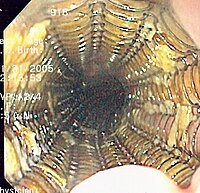
Photo from wikipedia
The removal of a proximally migrated pancreatic stent is technically challenging [1–3]. A novel device delivery system (EndoSheather; Piolax) was recently developed, which comprises a slim-tipped guide catheter and pusher… Click to show full abstract
The removal of a proximally migrated pancreatic stent is technically challenging [1–3]. A novel device delivery system (EndoSheather; Piolax) was recently developed, which comprises a slim-tipped guide catheter and pusher tube that facilitate the insertion of devices up to 1.9mm in diameter [4, 5]. An 80-year-old man was admitted to our hospital for treatment of choledocholithiasis. We removed the bile duct stone by performing endoscopic sphincterotomy; however, black stools were observed 2 days after the procedure. Emergency endoscopy revealed an exposed blood vessel in the papilla of Vater. We planned to perform hemostasis by injecting hypertonic saline and epinephrine after stenting both the bile and pancreatic ducts; however, the pancreatic stent (Geenen, 5 Fr, 3 cm; Cook Medical Japan) migrated during the procedure. We were unable to remove the migrated pancreatic stent despite attempts with several different devices, including a dilation balloon, stone removal balloon, and basket catheter, with the stent finally ending up in the tail of the pancreatic duct (PD) (▶Fig. 1 a). We therefore replaced the additional pancreatic stent, and the procedure was terminated once hemostasis had been achieved. Cessation of the bleeding was confirmed 2 days later, when we also attempted to remove the migrated pancreatic stent. First, a guidewire (EndoSelector; Boston Scientific) was placed on the proximal side of the PD. Second, the novel device delivery system (EndoSheather) was inserted close to the migrated pancreatic stent, and the inner catheter was removed (▶Fig. 1b). A biopsy forceps with a 1.8-mm diameter (Radial Jaw; Boston Scientific) was then inserted through the sheath; however, it was not possible to open the jaws because of the narrow PD. We therefore used a smaller biopsy forceps with a 1-mm diameter (SpyBite; Boston Scientific) to grasp the migrated pancreatic stent (▶Fig. 1 c). Finally, we pulled the biopsy forceps up into the outer sheath of the device (▶Fig. 1d) and were able to successfully remove the migrated stent (▶Fig. 2). Endoscopic nasopancreatic drainage was subsequently performed to prevent pancreatitis due to clots (▶Video 1), and the patient was discharged without further complications.
Journal Title: Endoscopy
Year Published: 2023
Link to full text (if available)
Share on Social Media: Sign Up to like & get
recommendations!